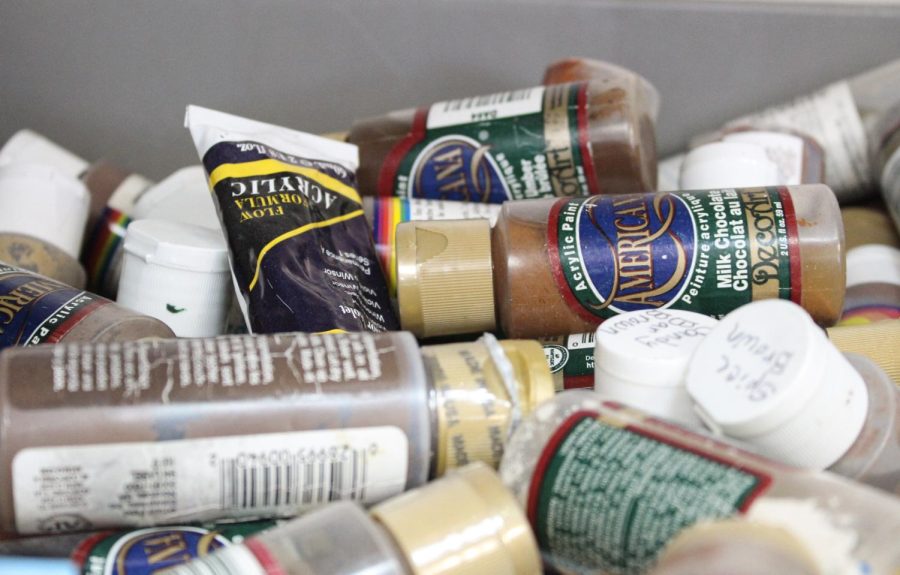Art and Recycling: How Local Art Institutions Make Do and Reuse
(Photo by Brooklyn Critchley | The Daily Utah Chronicle)
November 4, 2021
Climate change is a looming issue that has been at the forefront of environmental discussion for many decades now. Sustainably efforts are ever-expanding and the dialogue around how we use and reuse our resources is growing.
This is a topic that is increasingly centered in the art world as people move between physical and digital mediums and explore the intersections of social justice issues like climate change and practices in sustainability. At the U, and across the Salt Lake Valley, students and artists address these issues in a number of ways.
Waste in Practice
“Art is very wasteful,” said Visual Arts Professor Maureen O’Hara Ure. “My students and I go through a grundle of materials.”
This is something that’s true for many artists – the process of creating art can amass serious waste. Paper and plastic waste are quite common and waste from materials like paint makes up a considerable portion of the microplastics that end up in the ocean and landfills. In addition to the waste used to produce physical works of art, information is surfacing on the negative environmental impacts of digital art mediums like NFTs.
Waste reduction and proper hazard disposal is a necessary component of art studies. Many argue that this and other sustainable practices can offset the impact of waste within the arts: “I have no intention of stopping my consumption of art materials,” O’Hara Ure said. “It would be like saying to the musician, ‘well don’t play as much.’ I express my interest in sustainability in other ways, in terms of recycling and avoiding fast fashion.”
It is certainly helpful for artists to apply sustainability efforts to other facets of their lives, but an all-or-nothing approach to thinking about waste in artistic practice might not be. There are absolutely ways to freely continue creative pursuits while still being environmentally conscious, and there are a few local institutions that are great examples of that.
Saving with Cephalopods
One of the ways students are engaging with these issues is by making use of local resources like Clever Octopus, a South Salt Lake institution that promotes the intersection of art and sustainability in the University of Utah’s own backyard.
Their mission as a creative reuse center is to “take unwanted or unused items and turn them into functional, practical, or artistic creations. By extending the life of usable materials, creative reuse diverts waste from going to the land fill.”
The store houses second-hand art materials ranging from paint and craft supplies to other recycled materials like wood and canvas. In addition to being environmentally friendly, these items can be purchased for much cheaper than retail price which helps in making art more accessible.
“We get people excited about making stuff with things that otherwise would have gone to the trash,” says Co-Founder Jen Lopez. Clever Octopus runs donation drives where individuals can recycle their unwanted art supplies, as well as purchase second-hand materials from suppliers such as 3 Form. The refuse center provides low-cost creative materials that not only work to promote sustainability by reducing waste but also make creating art increasingly accessible to all people.
“I don’t think we think about the role that waste plays in our lives,” says Co-Founder Sheri Gibb, “Once we discard, we stop thinking.” Clever Octopus allows otherwise wasted materials a second life without hindering artistic processes.
Finding Hope in Found Art
Another great example of reuse in the artistic process is found art. This method, which dates back roughly 100 years to Michael Duchamp’s 1917 work “Fountain,” is a way of making discarded materials into art. This movement has gained popularity since Duchamp’s highly controversial display and has become a rich artistic tradition over the years with engagement from some of the last century’s most prolific artists.
One of the biggest local proponents of found art is the Utah Arts Alliance. Their headquarters houses an expanse of second-hand materials for artists in residence and their largest installation, “Dreamscapes,” was created by hundreds of artists using only found objects. The wide success of “Dreamscapes” is a testament to the endless possibilities of sustainable art practices.
The climate crisis is a persistent, intersectional issue. It impacts all of us, and the art world is no exception. Local students and artists are proving that there are a plethora of ways to reduce the waste our art creates, plenty of which do not interrupt necessary artistic craft and can actually aid in making art that addresses contemporary issues.









